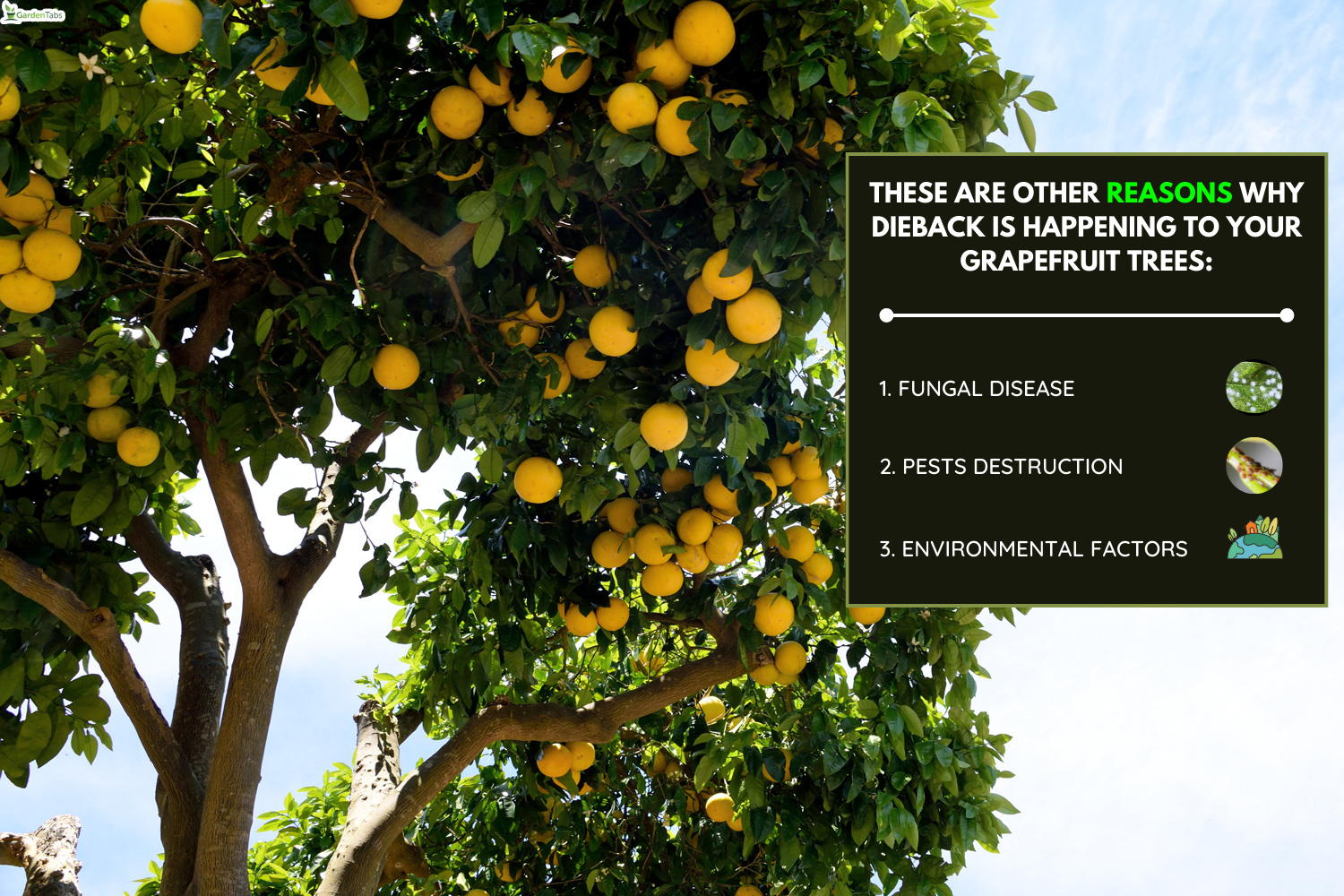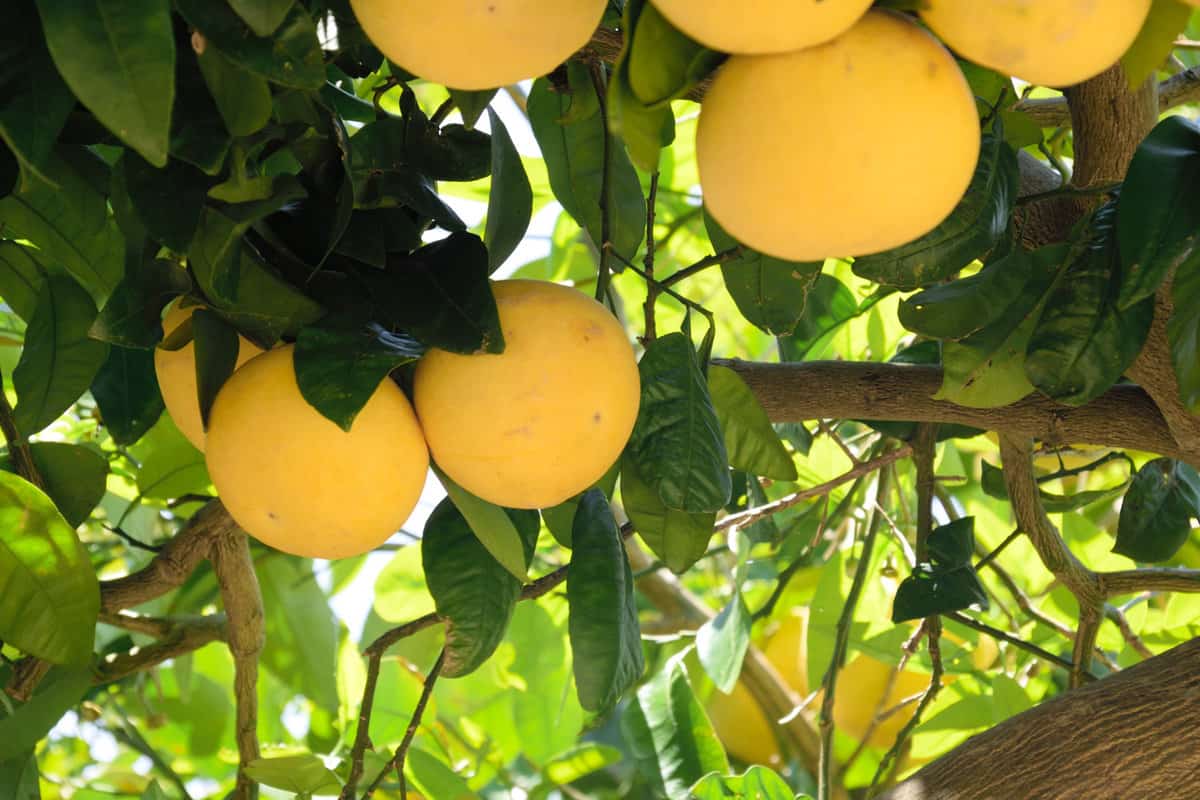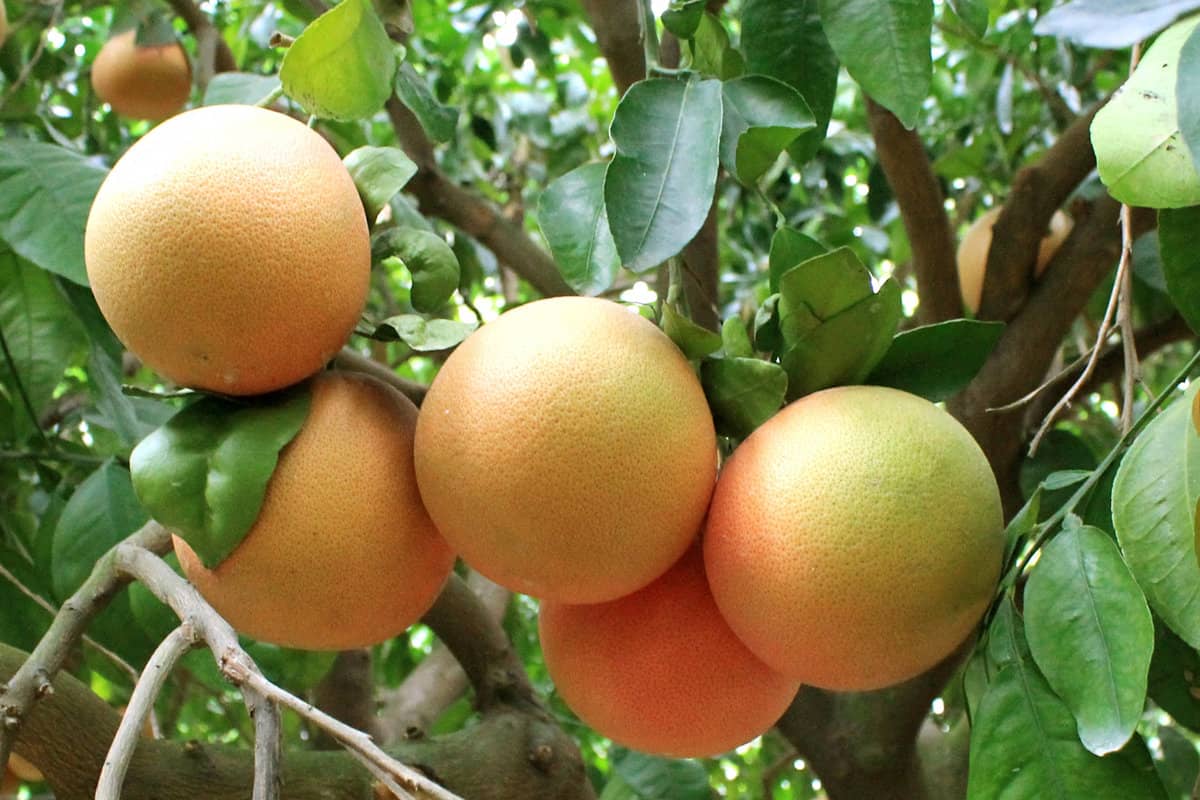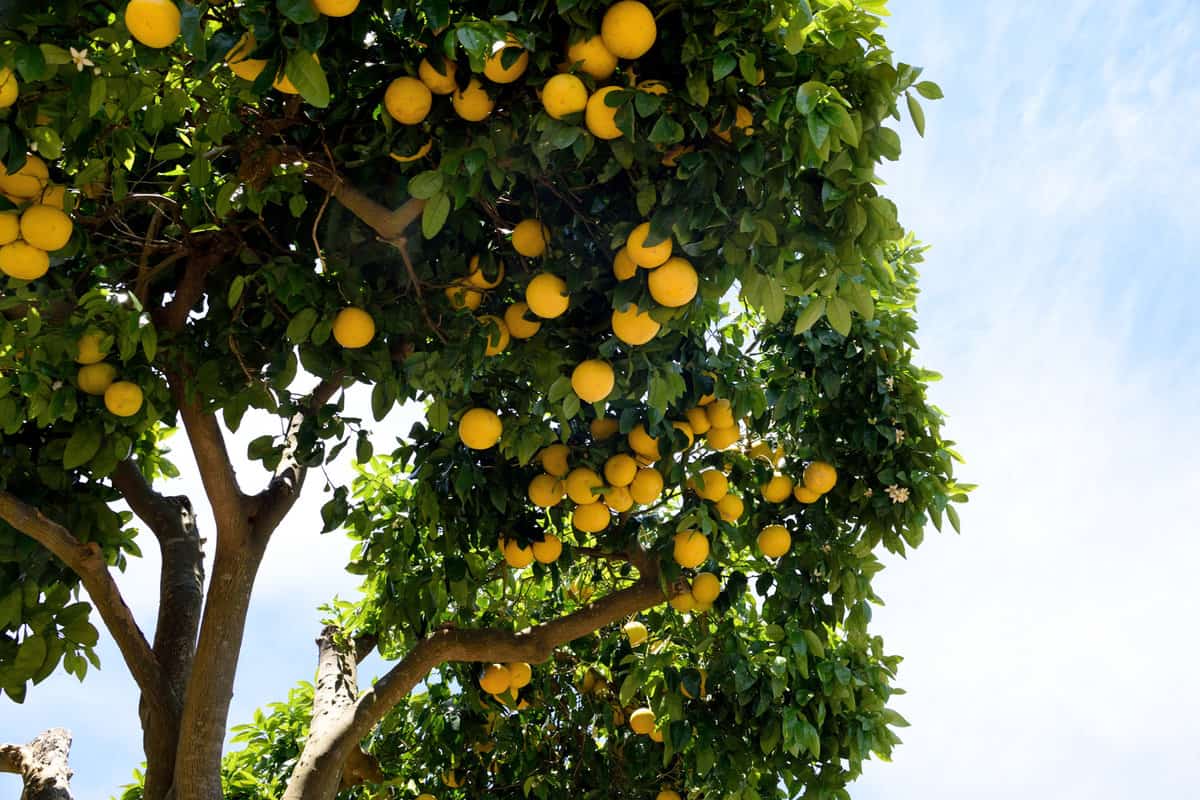If you see dead or dying branches on your grapefruit tree, don't panic just yet. Luckily, we've scoured the net to help you understand what brings about such conditions.
Grapefruit trees can be susceptible to dieback, which results in the yellowing or death of leaves and branches. These are the reasons why dieback is happening to your grapefruit trees:
- Fungal Disease
- Pests Destruction
- Environmental Factors
Continue reading for more details about the causes of dieback. We'll also delve into how to make your backyard or farm better by saving your grapefruit tree!

The Grapefruit Tree
The grapefruit tree is a member of the citrus family and is thought to be a hybrid of the orange and pummelo. The tree is native to Asia and the Indian subcontinent, but it is now grown in many parts of the world.
The grapefruit is a large, evergreen tree that can grow up to 20 feet tall and 10 feet wide. The leaves are dark green and glossy, and the white flowers are fragrant.

The fruit of the grapefruit tree is, of course, the grapefruit. Grapefruits vary in color but are typically yellow or pink on the inside with a thick, bitter rind.
Fruits are high in Vitamin C and antioxidants and have a variety of culinary uses. In addition to being eaten fresh, grapefruits can be juiced, made into marmalade, or used as a flavor ingredient in baked goods and other dishes.
What Causes Grapefruit Tree Branches to Die?

One of the most frustrating things that can happen to a grapefruit tree is to have its branches die. Not only is it unsightly, but it can also reduce the amount of fruit produced.
Grapefruit tree branches may go through dieback and die due to the following:
Fungal Disease
One of the most common causes of branch death is a fungal disease known as Ganoderma butt rot. This disease affects the lower trunk and roots of the grapefruit tree, causing the bark to peel and the wood to decay.
The fungus can spread to the upper parts of the tree, eventually causing the branches to die. Ganoderma butt rot is difficult to control, and once a tree is infected, it is often best to remove it and start over with a new tree.
Pest Destruction
Pests can also cause grapefruit tree branches to die. The citrus blackfly is a particularly destructive pest that attacks grapefruit trees. The larvae burrow into the branches, causing them to weaken and eventually die.
Citrus blackflies are difficult to control, and they can quickly devastate a grapefruit orchard. In addition to being a nuisance, they can also spread diseases from one tree to another.
Environmental Factors
Environmental stress can also cause grapefruit tree branches to die. Cold weather can damage the bark of citrus trees, making them susceptible to disease.
In addition, drought can cause the leaves of a grapefruit tree to turn yellow and fall off. If left unchecked, these stressors can eventually kill the entire tree.
Why Do Grapefruit Trees Suffer Dieback?
Dieback is a plant disease that can happen in a grapefruit tree. It can affect trees, shrubs, and herbaceous plants. It is characterized by the sudden death of leaves, branches, or even the entire plant.
Dieback can be hard to determine and can be caused by a number of factors, including pests, pathogens, environmental stressors, and nutrient deficiencies.
Left unchecked, dieback in grapefruit trees can cause extensive damage to plant life and lead to the death of individual trees or even whole orchards. In many cases, dieback can be controlled through early detection and treatment. Preventing dieback is essential to protecting the health of plants and ecosystems.
What Are the Symptoms of Grapefruit Tree Branches Dying?

If you notice that your grapefruit tree branches are dying, it's important to take action immediately. Here are some symptoms to look out for:
Physical Damage
Some of the most common signs that grapefruit tree branches are dying are when the leaves start to turn yellow, wilt, discolor, or fall off prematurely.
This happens because the leaves are not getting enough nutrients, which could be due to a number of reasons, including pests, disease, or lacking water.
Dying branches could be brown or black and brittle to the touch. The bark might be cracked, peeling, or showing signs of decay. Additionally, fungal diseases could be present and visible on the leaves or branches.
Fruit Yield and Quality
When branches die, they no longer produce fruit. This can lead to a decrease in the overall number of grapefruits produced by the tree.
In addition, the quality of the grapefruits produced may also be affected. For example, if the branches that produce the most fruits are the ones that die, then the remaining fruits would be smaller in size.
Overall Tree Health
If you notice that the branches of your grapefruit tree are dying, it's important to take action immediately. This problem can quickly spread throughout the tree, leading to an overall decline in health.
Other symptoms you can check include increased insect activity around the tree, new growth that is stunted or deformed, and sap that is oozing from the trunk or branches.
If you see any of these symptoms, you must contact a certified arborist for an inspection and diagnosis. By taking action early, you can help save your grapefruit tree from further damage that is often difficult to treat.
Once the cause of the problem is determined, they can recommend the best course of treatment to save your grapefruit tree and prevent additional damage.
What Should You Do if Your Grapefruit Tree Branches Are Already Dead?

If your grapefruit tree branches are already dead, you have a few options for what to do next.
- One option is to cut off the dead branches or pruning. This will help to improve the overall appearance of the tree and encourage new growth. Regular pruning helps to keep trees healthy by removing diseased or damaged wood.
- In addition, maintaining proper irrigation levels can help trees withstand environmental stressors.
- Another option is to leave the dead branches in place and allow them to decompose naturally. This will provide valuable nutrients for the soil and may attract beneficial insects.
- Finally, you could also remove the entire tree and start again with a new one. Whichever option you choose, be sure to take care of your grapefruit tree to prevent future problems.
How Can You Prevent Grapefruit Tree Branches From Dying?
Grapefruit trees are susceptible to a number of diseases that can cause the branches to die. The most common are root rot, trunk rot, and foliar diseases.
To prevent these diseases from taking hold, it is important to water the tree regularly and deeply, especially during periods of drought. Make sure the soil around the tree is well-drained, and avoid overwatering.
It is also important to prune the tree regularly to remove dead or dying branches. This will help promote air circulation and allow more sunlight to reach the leaves.
In addition, applying a copper fungicide and fertilization can help to prevent grapefruit tree diseases. If the soil is too dry, it can cause the leaves of the grapefruit tree to drop off.
Get copper fungicide on Amazon.
What are the Different Ways to Grow Your Grapefruit Tree Properly?
Grapefruit trees require full sun and well-drained soil to grow properly. They are also very sensitive to cold weather, so it is important to plant them in an area that will provide protection from frost.
Here are some details on growing a grapefruit tree properly:
Pick the Right Location
Grapefruit trees need full sun and well-drained soil. They are also quite sensitive to cold weather, so it's important to choose a spot that is protected from strong winds.
Give Your Tree a Good Start
When planting your grapefruit tree, be sure to dig a hole that is twice as wide as the tree's root ball. This will give the roots plenty of room to spread out and grow.
Water, Prune, and Fertilize Regularly
Grapefruit trees are drought-tolerant, but they will produce more fruit if kept moist. Water your tree deeply once a week, ensuring the soil stays evenly moist.
Grapefruit trees need regular fertilization to produce bountiful fruit harvests. Use a citrus fertilizer according to the manufacturer's directions.
You should prune the trees in early spring to remove any dead or diseased branches. They can also be pruned to control their size and shape.
Protect from Pests and Diseases
Grapefruit trees are susceptible to many pests and diseases, so it's important to take steps to prevent problems before they start. Regularly inspect your tree for signs of pests or disease, and take action immediately if you see anything suspicious.
Another way to protect the grapefruit tree is to wrap the trunk with a protective material, such as burlap or chicken wire.
Harvest Grapefruits When They’re Ripe
The best way to tell if a grapefruit is ripe is to taste it yourself! Ripe grapefruits will be sweet and juicy, with a very little tartness. Cut the fruit from the tree with a sharp knife, taking care not to damage the branches.
Final Words
Now that you know how to save your grapefruit tree, you can prevent any diebacks. With a little bit of care, your grapefruit trees will thrive for years to come.
If you'll need additional information to help you maintain your backyard, check the links below:
Fruit Trees With Non-Invasive Roots
Why Do Paper Birch Trees Peel?



